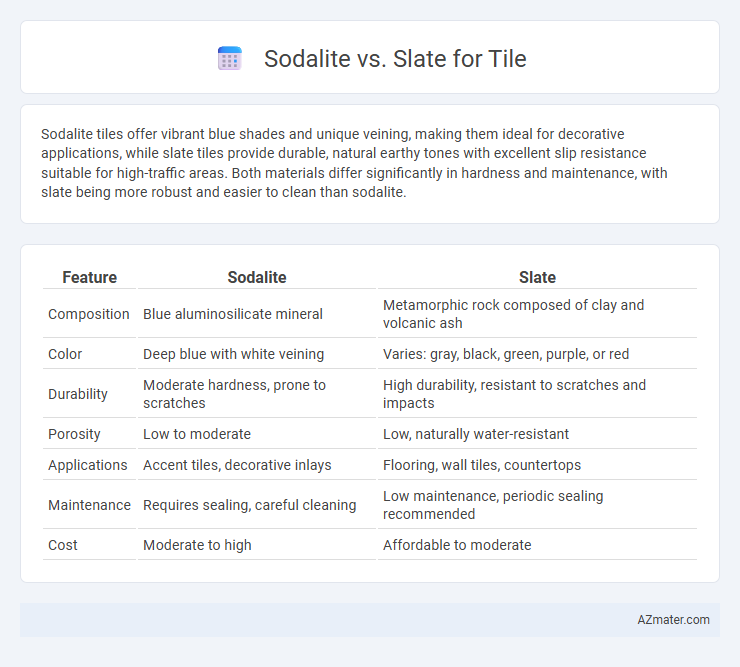Sodalite tiles offer vibrant blue shades and unique veining, making them ideal for decorative applications, while slate tiles provide durable, natural earthy tones with excellent slip resistance suitable for high-traffic areas. Both materials differ significantly in hardness and maintenance, with slate being more robust and easier to clean than sodalite.
Table of Comparison
| Feature | Sodalite | Slate |
|---|---|---|
| Composition | Blue aluminosilicate mineral | Metamorphic rock composed of clay and volcanic ash |
| Color | Deep blue with white veining | Varies: gray, black, green, purple, or red |
| Durability | Moderate hardness, prone to scratches | High durability, resistant to scratches and impacts |
| Porosity | Low to moderate | Low, naturally water-resistant |
| Applications | Accent tiles, decorative inlays | Flooring, wall tiles, countertops |
| Maintenance | Requires sealing, careful cleaning | Low maintenance, periodic sealing recommended |
| Cost | Moderate to high | Affordable to moderate |
Introduction to Sodalite and Slate Tiles
Sodalite tiles are valued for their rich blue color with white veining, making them a striking choice for decorative interiors and accent walls. Slate tiles, renowned for their durability and natural layered texture, offer a versatile range of earth tones suitable for both indoor and outdoor flooring. Both materials provide unique aesthetic qualities, with sodalite excelling in bold visual appeal and slate in rugged, timeless elegance.
Origins and Geological Formation
Sodalite primarily forms in igneous rocks such as nepheline syenites through the crystallization of magma rich in sodium and aluminum, typically found in regions like Canada, Brazil, and Russia. Slate originates from the metamorphism of shale or mudstone under low-grade regional metamorphic conditions, creating dense, fine-grained foliation layers commonly sourced from Wales, the United States, and Spain. The contrasting geological origins influence their mineral composition, durability, and appearance, impacting their suitability for tile applications.
Visual Appearance and Color Variations
Sodalite tiles exhibit deep blue hues with striking white veining, creating a vibrant and dynamic visual appeal ideal for statement spaces. Slate tiles offer more subdued, earthy tones ranging from gray to green and rust, providing a natural, rustic look with subtle color variations. The vibrant, intense coloration of sodalite contrasts sharply with slate's muted, layered textures, making each suitable for different design aesthetics.
Durability and Hardness Comparison
Sodalite tile offers moderate durability with a Mohs hardness of around 5.5 to 6, making it suitable for low-traffic areas but prone to scratches and etching under heavy use. Slate tile, with a higher hardness range of 6 to 7, provides superior durability and resistance to abrasion, making it ideal for high-traffic flooring and exterior applications. Choosing slate over sodalite ensures better longevity and withstands wear in demanding environments.
Water and Stain Resistance
Sodalite tiles exhibit moderate water resistance but are more porous compared to slate, making them less effective in repelling stains without proper sealing. Slate tiles offer superior water and stain resistance due to their dense, fine-grained structure, ideal for high-moisture areas like bathrooms and kitchens. Regular sealing enhances the durability and appearance of both sodalite and slate tiles, but slate generally requires less maintenance to maintain its resistance properties.
Maintenance and Cleaning Requirements
Sodalite tiles require gentle cleaning with mild soap and water to preserve their deep blue color and avoid surface damage, as they are softer and more porous compared to slate. Slate tiles are highly durable and resist stains better, allowing for low-maintenance cleaning using pH-neutral cleaners and occasional sealing to maintain their natural texture. Both materials benefit from regular sealing to protect against moisture and stains, but slate's dense structure generally provides easier upkeep and more resilient performance under heavy use.
Installation Considerations
Sodalite tiles require careful handling during installation due to their relative softness and susceptibility to chipping compared to slate, which is denser and more durable, allowing for easier cutting and handling. Slate's natural cleft surface provides better slip resistance, making it ideal for wet areas, while sodalite's vibrant blue hues demand precise sealing to protect against staining and moisture. Proper substrate preparation and selecting the right thin-set mortar compatible with each stone's porosity are critical to achieving a stable and long-lasting installation.
Cost and Value Analysis
Sodalite tiles typically cost more than slate tiles due to their rarity and vibrant blue coloration, making sodalite a premium choice for luxury installations. Slate offers a more affordable option with durable properties and a natural range of earth tones, providing excellent value for budget-conscious projects. When assessing long-term value, sodalite's unique aesthetic can increase property appeal, while slate's proven durability and lower upfront cost ensure sustained practicality.
Best Applications and Use Cases
Sodalite is best suited for decorative applications such as accent walls, countertops, and artisanal tiles due to its striking blue and white patterns that add visual interest. Slate excels in flooring, outdoor patios, and roof shingles because of its durability, slip resistance, and natural cleft surface that handles heavy foot traffic and weather exposure effectively. Choosing between sodalite and slate depends on the balance of aesthetic appeal and functional requirements in residential or commercial design projects.
Sodalite vs Slate: Final Verdict
Sodalite offers a vibrant blue hue with unique white veining, making it a standout choice for decorative tile installations, while slate provides exceptional durability and a natural, earthy aesthetic ideal for high-traffic areas. Both materials perform well in indoor and outdoor settings, but sodalite requires more maintenance due to its softer composition compared to the dense, hard-wearing slate. For projects demanding striking visual appeal and moderate durability, sodalite excels, whereas slate is preferable for long-lasting, versatile applications.

Infographic: Sodalite vs Slate for Tile
 azmater.com
azmater.com